Air INFINITI QX56 2010 Factory Service Manual
[x] Cancel search | Manufacturer: INFINITI, Model Year: 2010, Model line: QX56, Model: INFINITI QX56 2010Pages: 4210, PDF Size: 81.91 MB
Page 740 of 4210
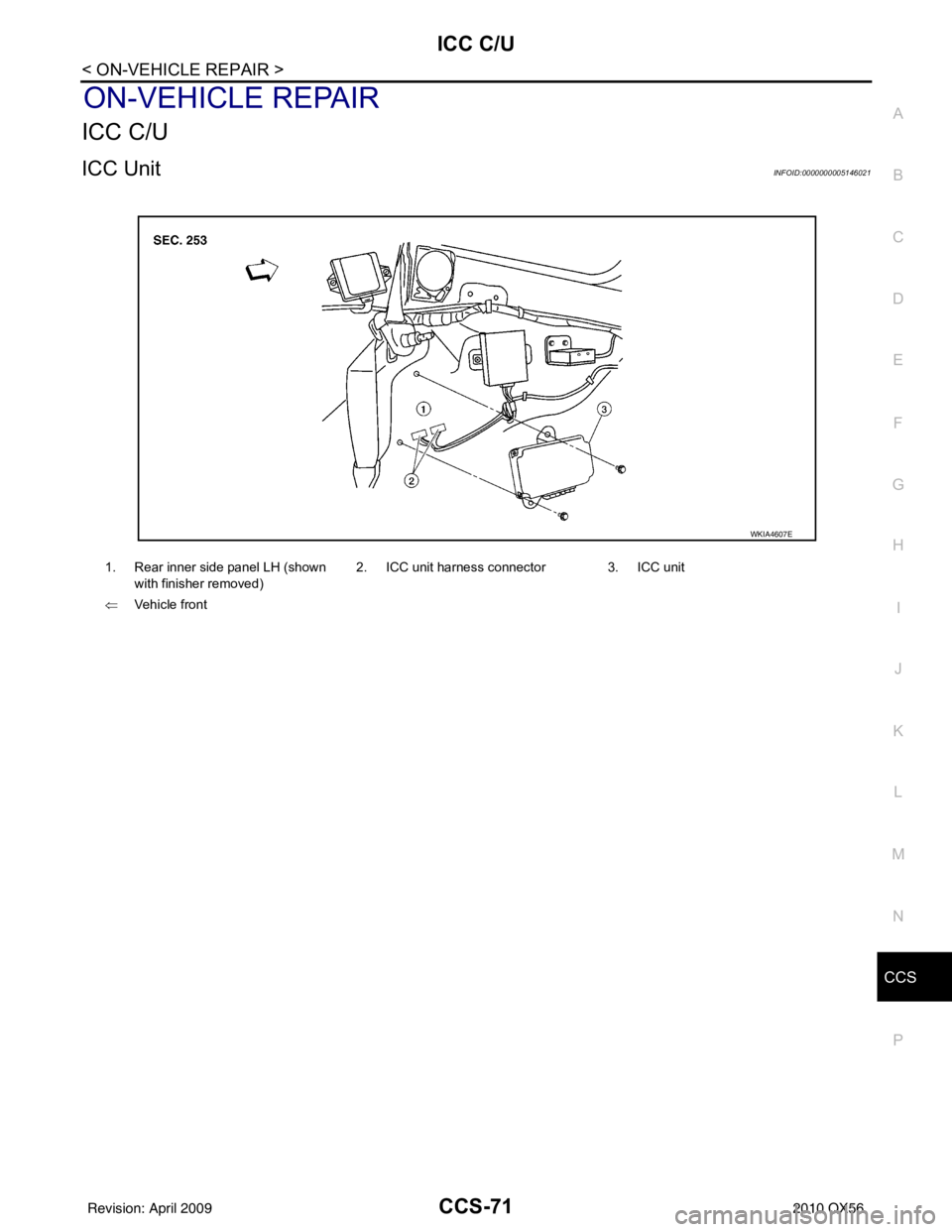
CCS
ICC C/UCCS-71
< ON-VEHICLE REPAIR >
C
DE
F
G H
I
J
K L
M B
N P A
ON-VEHICLE REPAIR
ICC C/U
ICC UnitINFOID:0000000005146021
1. Rear inner side panel LH (shown with finisher removed) 2. ICC unit harness connector 3. ICC unit
⇐ Vehicle front
WKIA4607E
Revision: April 20092010 QX56
Page 741 of 4210

CCS-72
< ON-VEHICLE REPAIR >
ICC SENSOR INTEGRATED UNIT
ICC SENSOR INTEGRATED UNIT
ICC SensorINFOID:0000000005146022
CAUTION:
Perform the laser beam aiming procedure every time the ICC sensor is removed or installed. Refer to
CCS-5
.
1. ICC sensor bracket 2. ICC frame bracket3. ICC sensor
4. Frame side rail ⇐Vehicle front
WKIA4608E
Revision: April 20092010 QX56
Page 742 of 4210
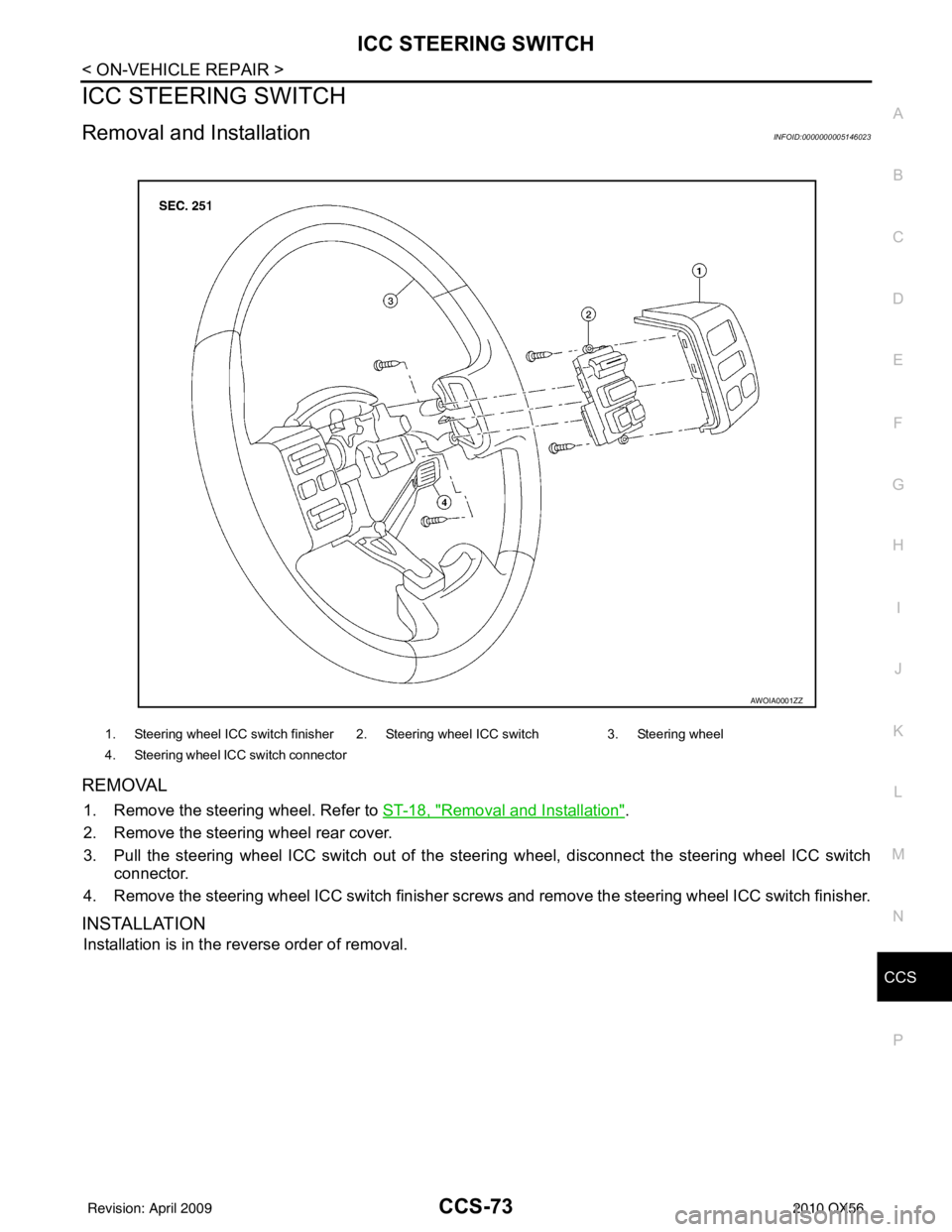
CCS
ICC STEERING SWITCHCCS-73
< ON-VEHICLE REPAIR >
C
DE
F
G H
I
J
K L
M B
N P A
ICC STEERING SWITCH
Removal and InstallationINFOID:0000000005146023
REMOVAL
1. Remove the steering wheel. Refer to ST-18, "Removal and Installation".
2. Remove the steering wheel rear cover.
3. Pull the steering wheel ICC switch out of the steering wheel, disconnect the steering wheel ICC switch
connector.
4. Remove the steering wheel ICC switch finisher scre ws and remove the steering wheel ICC switch finisher.
INSTALLATION
Installation is in the reverse order of removal.
1. Steering wheel ICC switch finisher 2. Steering wheel ICC switch 3. Steering wheel
4. Steering wheel ICC switch connector
AWOIA0001ZZ
Revision: April 20092010 QX56
Page 743 of 4210

CHG
CHG-1
ELECTRICAL & POWER CONTROL
C
DE
F
G H
I
J
K L
B
SECTION CHG
A
O P
N
CONTENTS
CHARGING SYSTEM
PRECAUTION .......
........................................2
PRECAUTIONS .............................................. .....2
Precaution for Supplemental Restraint System
(SRS) "AIR BAG" and "SEAT BELT PRE-TEN-
SIONER" ............................................................. ......
2
Precaution Necessary for Steering Wheel Rota-
tion After Battery Disconnect ............................... ......
2
Precaution for Power Generation Variable Voltage
Control System ..........................................................
3
PREPARATION ............................................4
PREPARATION .............................................. .....4
Special Service Tool ........................................... ......4
Commercial Service Tool ..........................................4
BASIC INSPECTION ....................................5
DIAGNOSIS AND REPAIR WORKFLOW ..... .....5
Work Flow ........................................................... ......5
FUNCTION DIAGNOSIS ...............................6
CHARGING SYSTEM ..................................... .....6
System Diagram .................................................. ......6
System Description ...................................................6
Component Description ............................................6
POWER GENERATION VOLTAGE VARI-
ABLE CONTROL SYSTEM .................................
7
System Diagram .................................................. ......7
System Description ...................................................7
Component Description .............................................7
COMPONENT DIAGNOSIS ..........................8
CHARGING SYSTEM PRELIMINARY IN-
SPECTION ....... ..................................................
8
Inspection Procedure ........................................... .....8
POWER GENERATION VOLTAGE VARI-
ABLE CONTROL SYSTEM OPERATION IN-
SPECTION .........................................................
9
Diagnosis Procedure ........................................... .....9
B TERMINAL CIRCUIT .....................................11
Description ...............................................................11
Diagnosis Procedure ...............................................11
L TERMINAL CIRCUIT .....................................12
Description ...............................................................12
Diagnosis Procedure ...............................................12
S TERMINAL CIRCUIT .....................................13
Description ...............................................................13
Diagnosis Procedure ...............................................13
CHARGING SYSTEM .......................................14
Wiring Diagram ........................................................14
SYMPTOM DIAGNOSIS ..............................20
CHARGING SYSTEM .......................................20
Symptom Table ................................................... ....20
ON-VEHICLE REPAIR .................................21
GENERATOR ....................................................21
Removal and Installation ..................................... ....21
SERVICE DATA AND SPECIFICATIONS
(SDS) ............... .......................................... ...
22
GENERATOR ....................................................22
Generator ............................................................ ....22
Revision: April 20092010 QX56
Page 744 of 4210
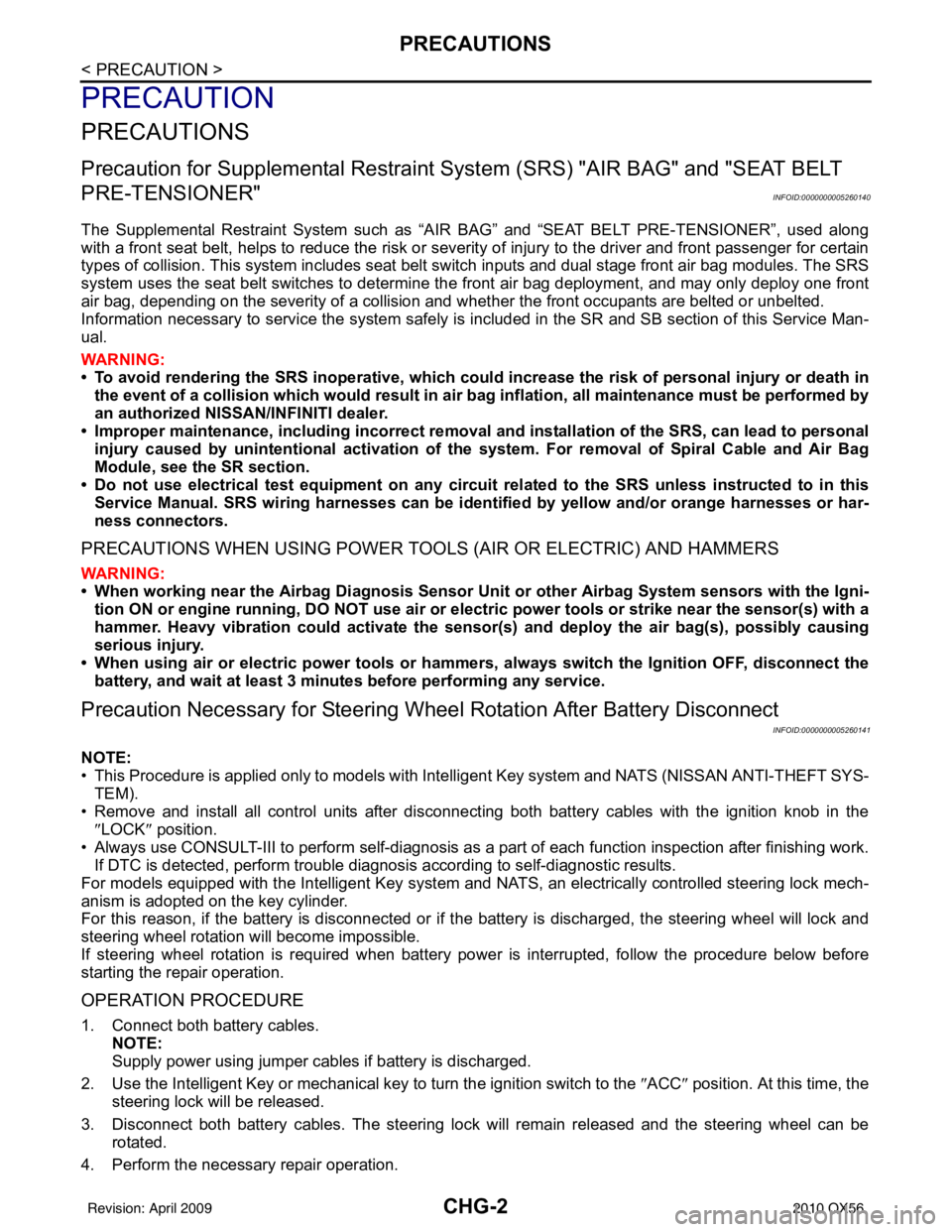
CHG-2
< PRECAUTION >
PRECAUTIONS
PRECAUTION
PRECAUTIONS
Precaution for Supplemental Restraint System (SRS) "AIR BAG" and "SEAT BELT
PRE-TENSIONER"
INFOID:0000000005260140
The Supplemental Restraint System such as “A IR BAG” and “SEAT BELT PRE-TENSIONER”, used along
with a front seat belt, helps to reduce the risk or severity of injury to the driver and front passenger for certain
types of collision. This system includes seat belt switch inputs and dual stage front air bag modules. The SRS
system uses the seat belt switches to determine the front air bag deployment, and may only deploy one front
air bag, depending on the severity of a collision and w hether the front occupants are belted or unbelted.
Information necessary to service the system safely is included in the SR and SB section of this Service Man-
ual.
WARNING:
• To avoid rendering the SRS inopera tive, which could increase the risk of personal injury or death in
the event of a collision which would result in air bag inflation, all maintenance must be performed by
an authorized NISSAN/INFINITI dealer.
• Improper maintenance, including in correct removal and installation of the SRS, can lead to personal
injury caused by unintent ional activation of the system. For re moval of Spiral Cable and Air Bag
Module, see the SR section.
• Do not use electrical test equipmen t on any circuit related to the SRS unless instructed to in this
Service Manual. SRS wiring harn esses can be identified by yellow and/or orange harnesses or har-
ness connectors.
PRECAUTIONS WHEN USING POWER TOOLS (AIR OR ELECTRIC) AND HAMMERS
WARNING:
• When working near the Airbag Diagnosis Sensor Unit or other Airbag System sensors with the Igni-
tion ON or engine running, DO NOT use air or electri c power tools or strike near the sensor(s) with a
hammer. Heavy vibration could activate the sensor( s) and deploy the air bag(s), possibly causing
serious injury.
• When using air or electric power tools or hammers , always switch the Ignition OFF, disconnect the
battery, and wait at least 3 minu tes before performing any service.
Precaution Necessary for Steering W heel Rotation After Battery Disconnect
INFOID:0000000005260141
NOTE:
• This Procedure is applied only to models with Intelligent Key system and NATS (NISSAN ANTI-THEFT SYS-
TEM).
• Remove and install all control units after disconnecting both battery cables with the ignition knob in the
″LOCK ″ position.
• Always use CONSULT-III to perform self-diagnosis as a part of each function inspection after finishing work.
If DTC is detected, perform trouble diagnosis according to self-diagnostic results.
For models equipped with the Intelligent Key system and NATS, an electrically controlled steering lock mech-
anism is adopted on the key cylinder.
For this reason, if the battery is disconnected or if the battery is discharged, the steering wheel will lock and
steering wheel rotation will become impossible.
If steering wheel rotation is required when battery pow er is interrupted, follow the procedure below before
starting the repair operation.
OPERATION PROCEDURE
1. Connect both battery cables. NOTE:
Supply power using jumper cables if battery is discharged.
2. Use the Intelligent Key or mechanical key to turn the ignition switch to the ″ACC ″ position. At this time, the
steering lock will be released.
3. Disconnect both battery cables. The steering lock will remain released and the steering wheel can be rotated.
4. Perform the necessary repair operation.
Revision: April 20092010 QX56
Page 745 of 4210

CHG
PRECAUTIONSCHG-3
< PRECAUTION >
C
DE
F
G H
I
J
K L
B A
O P
N
5. When the repair work is completed, return the ignition switch to the
″LOCK ″ position before connecting
the battery cables. (At this time, the steering lock mechanism will engage.)
6. Perform a self-diagnosis check of al l control units using CONSULT-III.
Precaution for Power Generation Variable Voltage Control SystemINFOID:0000000005146547
CAUTION:
For this model, the battery current sensor that is installed to the negative battery cable measures the
charging/discharging current of the battery and performs various engine controls. If an electrical com-
ponent is connected directly to the negative battery terminal, the current flowing through that compo-
nent will not be measured by the battery current sensor. This condition may cause a malfunction of
the engine control system and battery discharge m ay occur. Do not connect an electrical component
or ground wire directly to the battery terminal.
Revision: April 20092010 QX56
Page 747 of 4210
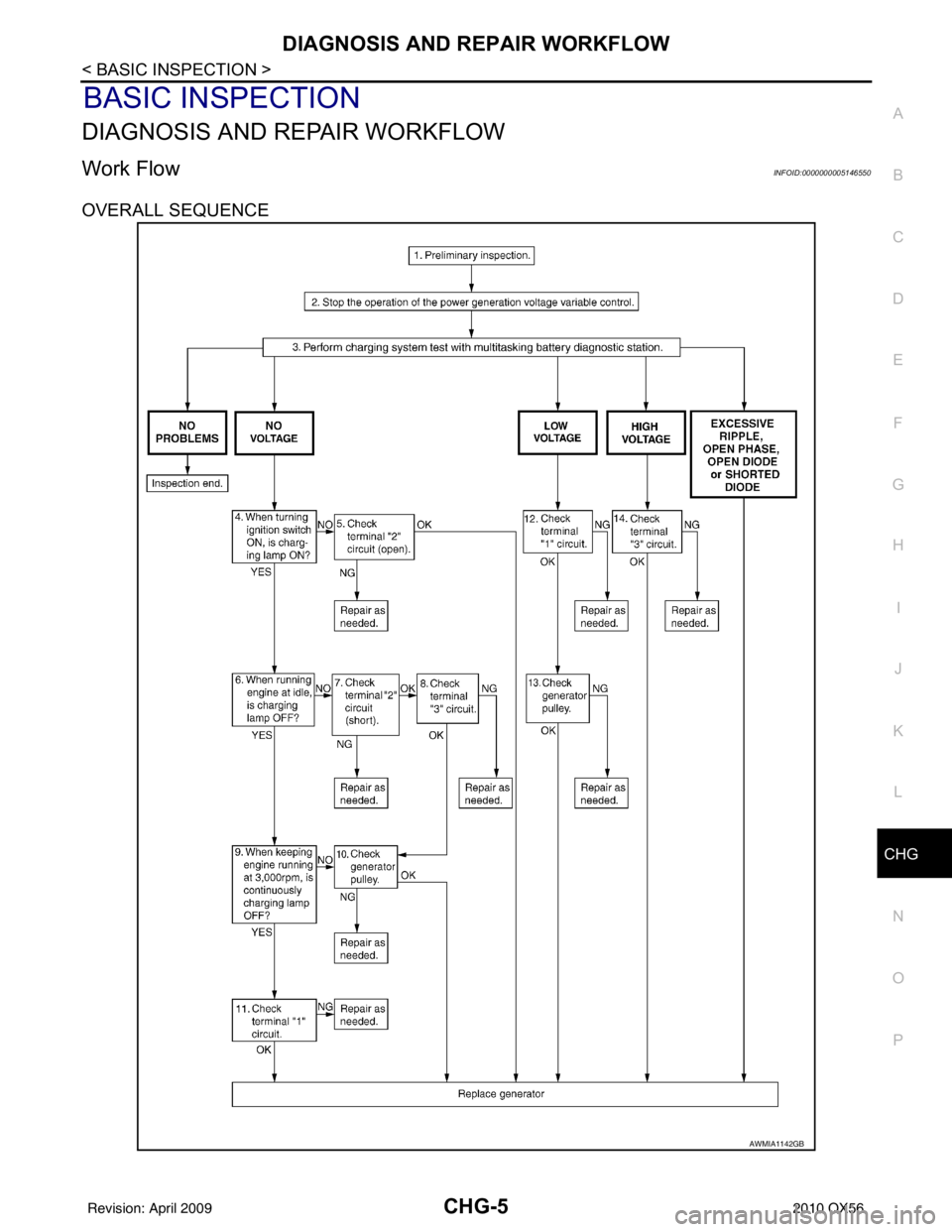
CHG
DIAGNOSIS AND REPAIR WORKFLOWCHG-5
< BASIC INSPECTION >
C
DE
F
G H
I
J
K L
B A
O P
N
BASIC INSPECTION
DIAGNOSIS AND REPAIR WORKFLOW
Work FlowINFOID:0000000005146550
OVERALL SEQUENCE
AWMIA1142GB
Revision: April 20092010 QX56
Page 750 of 4210

CHG-8
< COMPONENT DIAGNOSIS >
CHARGING SYSTEM PRELIMINARY INSPECTION
COMPONENT DIAGNOSIS
CHARGING SYSTEM PRELIMINARY INSPECTION
Inspection ProcedureINFOID:0000000005146557
1.CHECK BATTERY TERMINALS CONNECTION
Check if battery terminals are clean and tight.
Is the inspection result normal?
YES >> GO TO 2.
NO >> Repair battery terminals connection.
2.CHECK FUSE
Check for blown fuse and fusible link.
Is the inspection result normal?
YES >> GO TO 3.
NO >> Be sure to eliminate cause of malfunction before installing new fuse or fusible link.
3.CHECK GENERATOR GROUND TERMINAL CONNECTION
Verify connector E206 terminal 5 (generator ground harness) is clean and tight.
Is the inspection result normal?
YES >> GO TO 4.
NO >> Repair connection.
4.CHECK DRIVE BELT TENSION
Check drive belt tension. Refer to EM-13, "
Checking Drive Belts".
Is the inspection result normal?
YES >> Inspection End.
NO >> Repair as needed.
Unit Power source (Power supply terminals) Fuse or Fusible Link
Generator Battery (terminal 3)
Fuse 30
Battery (terminal 1) Fusible Link A
Combination meter Ignition switch ON (terminal 2) Fuse 14
Revision: April 20092010 QX56
Page 751 of 4210
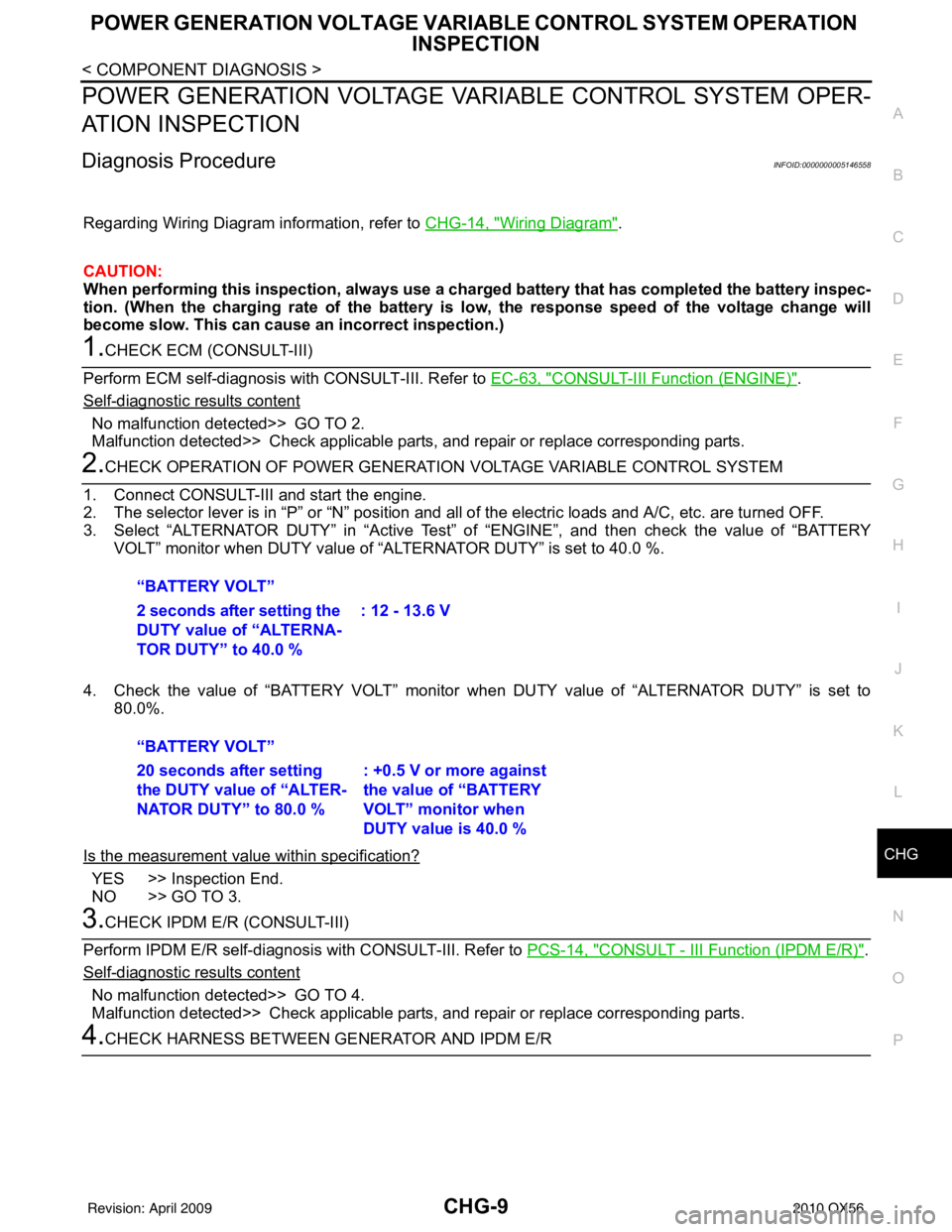
CHG
POWER GENERATION VOLTAGE VARIABLE CONTROL SYSTEM OPERATION
INSPECTION
CHG-9
< COMPONENT DIAGNOSIS >
C
DE
F
G H
I
J
K L
B A
O P
N
POWER GENERATION VOLTAGE VARI
ABLE CONTROL SYSTEM OPER-
ATION INSPECTION
Diagnosis ProcedureINFOID:0000000005146558
Regarding Wiring Diagram information, refer to CHG-14, "Wiring Diagram".
CAUTION:
When performing this inspection, always use a charged battery that has completed the battery inspec-
tion. (When the charging rate of the battery is low, the response speed of the voltage change will
become slow. This can cause an incorrect inspection.)
1.CHECK ECM (CONSULT-III)
Perform ECM self-diagnosis with CONSULT-III. Refer to EC-63, "
CONSULT-III Function (ENGINE)".
Self
-diagnostic results content
No malfunction detected>> GO TO 2.
Malfunction detected>> Check applicable parts, and repair or replace corresponding parts.
2.CHECK OPERATION OF POWER GENERATION VOLTAGE VARIABLE CONTROL SYSTEM
1. Connect CONSULT-III and start the engine.
2. The selector lever is in “P” or “N” position and a ll of the electric loads and A/C, etc. are turned OFF.
3. Select “ALTERNATOR DUTY” in “Active Test” of “ENGINE”, and then check the value of “BATTERY
VOLT” monitor when DUTY value of “ALTERNATOR DUTY” is set to 40.0 %.
4. Check the value of “BATTERY VOLT” monitor when DUTY value of “ALTERNATOR DUTY” is set to 80.0%.
Is the measurement val ue within specification?
YES >> Inspection End.
NO >> GO TO 3.
3.CHECK IPDM E/R (CONSULT-III)
Perform IPDM E/R self-diagnosis with CONSULT-III. Refer to PCS-14, "
CONSULT - III Function (IPDM E/R)".
Self
-diagnostic results content
No malfunction detected>> GO TO 4.
Malfunction detected>> Check applicable parts, and repair or replace corresponding parts.
4.CHECK HARNESS BETWEEN GE NERATOR AND IPDM E/R
“BATTERY VOLT”
2 seconds after setting the
DUTY value of “ALTERNA-
TOR DUTY” to 40.0 %
: 12 - 13.6 V
“BATTERY VOLT”
20 seconds after setting
the DUTY value of “ALTER-
NATOR DUTY” to 80.0 % : +0.5 V or more against
the value of “BATTERY
VOLT” monitor when
DUTY value is 40.0 %
Revision: April 20092010 QX56
Page 752 of 4210

CHG-10
< COMPONENT DIAGNOSIS >
POWER GENERATION VOLTAGE VARIABLE CONTROL SYSTEM OPERATION
INSPECTION
1. Turn ignition switch OFF.
2. Disconnect generator connector E205 and IPDM E/R connector
E122.
3. Check continuity between generator harness connector E205 (A) terminal 4 and IPDM E/R harness connector E122 (B) termi-
nal 37.
4. Check continuity between generator harness connector E122 (A) terminal 4 and ground.
Are the continuity test results as specified?
YES >> Replace IPDM E/R. Refer to PCS-35, "Removal and Installation of IPDM E/R".
NO >> Repair harness or connector between IPDM E/R and generator.
AB Continuity
Connector Terminal Connector Terminal
E205 4E122 37Yes
A —Contin u it y
Connector Terminal
E205 4Ground No
ALMIA0196ZZ
Revision: April 20092010 QX56